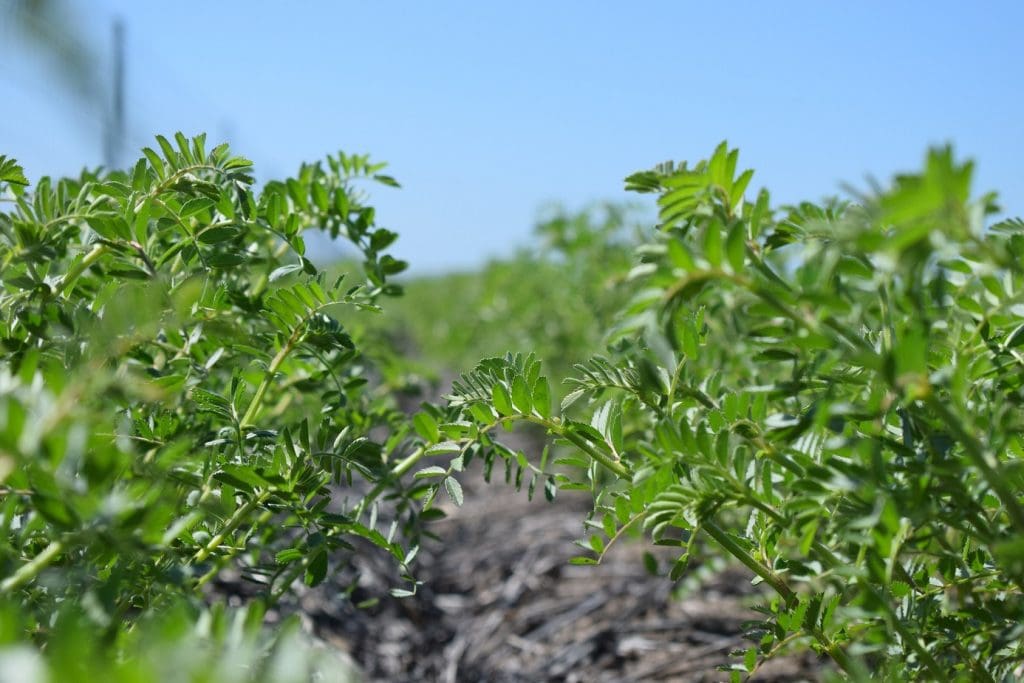
Pulse crops like chickpeas have potential to boost soil nitrogen levels by fixing nitrogen from the atmosphere, but not in situations where soil nitrogen is already abundantly available.
THE widely-held assumption that pulse crops boost soil nitrogen levels for following crops may not hold true in some instances, particularly where farmers are focussed on maximising grain yield potential.
Paradoxically, research is showing that rather than boosting soil nitrogen, legume crops in certain farming situations can deplete nitrogen levels by drawing down existing soil nitrogen, not fixing any additional nitrogen and exporting nitrogen in the grain.
Queensland Department of Agriculture and Fisheries (QDAF) extension officer and regional agronomy team leader, David Lawrence, said farmers who incorporated pulses into their rotations might not realise they were not always achieving a nitrogen benefit.

David Lawrence
“We all know that if you plant legumes and inoculate them properly with rhizobia they have the capacity to fix nitrogen from the atmosphere. The nodules in their roots help fix the nitrogen, and when the plant dies down that nitrogen is released to the ground. So, farmers think they can put a legume in and fix nitrogen in their soil,” he said.
“That can be true, but if the soil has enough nitrogen for the legume to grow anyway it will grow without fixing nitrogen. It will use the nitrogen that is available.
“Modern farmers are so good at growing legumes now with really big yields with crops like chickpeas. Often they are planted in part of the rotation where the soil has enough nitrogen in it already. That chickpea may grow, take up all the nitrogen from the soil, not fix much, and then the chickpea yields are so high that they often export quite a lot of nitrogen in the grain.
“So, the end result is that if you plant a legume in a rotation when there is quite a lot of nitrogen available you can end up with less nitrogen than if you had planted it when there was low nitrogen in the soil.”
Trial results
Dr Lawrence said the pulse/nitrogen scenario was identified in trial data drawn from the Northern Farming Systems Project run by QDAF, CSIRO and the NSW Department of Primary Industries and funded by GRDC.
The project has been running for seven years looking at long term farming systems across seven sites at Emerald, Pampas, Mungindi and Goondiwindi in Queensland and Narrabri, Spring Ridge and Trangie in NSW.
Dr Lawrence said one of the scenarios the trial assessed was what happened to nitrogen if more pulse crops were included in the farming rotation.
“We expected that to supply more nitrogen into the system, but what we are finding overall is that it is not because often the system had enough nitrogen. By including more pulses we are exporting more nitrogen and reducing the available nitrogen in the soil in the long term.”
………….if you plant a legume in a rotation when there is quite a lot of nitrogen available you can end up with less nitrogen than if you had planted it when there was low nitrogen in the soil
Profit first priority
Dr Lawrence said in soils that were deficient in nitrogen legumes had the potential to provide additional nitrogen, but pulses were often sown into soils with high levels of available nitrogen.
“If I’m a farmer at Narrabri, Emerald or Roma, my first instinct is to grow a crop because it is profitable. If a pulse crop is profitable I’m going to grow it, then think about the nitrogen benefit as a secondary issue,” he said.
“So, if you are growing it for profit you may plant it when there is enough nitrogen anyway. If you do that you are probably not contributing a lot of nitrogen to your system.
“Legumes won’t solve nitrogen problems completely. But if you are following a big sorghum crop and have no nitrogen in the soil, then a legume will do a fantastic job for you.”
Biomass the key
Dr Lawrence said the amount of nitrogen put back into the soil by a pulse crop depended on how big the crop was and how much biomass was returned to the soil.
“Faba beans are probably the best for building up nitrogen because they have a big biomass and a smaller proportion of the total biomass is exported as grain. Chickpeas have big yields, smaller biomass and therefore less nitrogen contribution,” he said.
“So, if you want to maximise nitrogen input, plant chickpeas or other legumes when there is very little available nitrogen in the soil. Double cropping situations would be a situation like that.
“But, generally, people are just looking at where the biggest profitability is for the system, so mungbeans and chickpeas often get planted when there is not going to be much nitrogen benefit.”
Grain Central: Get our free cropping news straight to your inbox – Click here

Research on the role of lucerne in cereal rotations was conducted at Tamworth Res. Centre by Dr Ian Holford in the 1960’s and 1970’s. Ian found that a healthy lucerne pasture of 7 years duration produced measurable increases in cereal yields and quality for the next 7 years. Being a perennial species which continuously fixed nitrogen during that time, and it had a longer lasting effect than annual pulse crops.